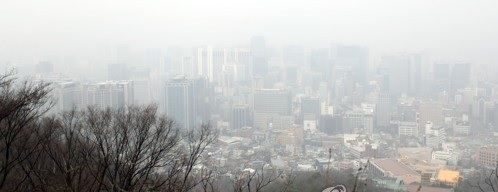South Korea was blanketed by a high level of particulate pollution Tuesday, prompting emergency dust reduction measures for the first time this winter and an ultrafine dust advisory issued in the afternoon.
 |
(Yonhap) |
The implementation of emergency measures was extended into Wednesday with the high level of PM 2.5 -- ultrafine particles less than 2.5 micrometers in diameter -- expected to continue across the country due to the stagnant air over the peninsula and the inflow of particles from abroad.
Seoul, Incheon, Gyeonggi Province and North Chungcheong Province were to be under the emergency measures for the second consecutive day Wednesday. The measures were expanded to South Chungcheong Province, Sejong, Daegu, Busan and the southern part of Gangwon Province.
A cold front from the northwest was forecast to hit the country Wednesday evening, with the temperature expected to drop to below zero degrees Celsius on Thursday morning, according to the Korea Meteorological Administration.
Ultrafine dust advisories are issued when the level of PM 2.5 exceeds 75 micrograms per cubic meter for two consecutive hours.
As of 1 p.m., the PM 2.5 reading was 98 micrograms per cubic meter in Seoul, 82 in Daegu, 101 in the central part of Gyeonggi Province, 97 in the northern part of the province, and 83 in the western part of South Chungcheong Province.
A day earlier, the Ministry of Environment put in place emergency fine dust reduction measures in Seoul, Gyeonggi Province and North Chungcheong Province, which were effective from 6 a.m. to 9 p.m., to curb particulate pollution.
Under the measures, 10 coal-fired power plants out of 60 halted operations. The use of grade 5 emission vehicles was banned from Seoul and Gyeonggi Province, and those who violate the rule face fines of 100,000 won ($84).
The Seoul Metropolitan Government said it had caught some 4,540 grade 5 emission vehicles from 51 locations on major roads in Seoul while the emergency measures were in place Tuesday.
An alternate-day no-driving system was implemented for vehicles owned by public institutions and civil servants. On Tuesday, only public vehicles with even-numbered license plates were allowed on the roads.
Meanwhile, the government earlier in the day announced that it would lower the level of toxic dust in the country to that recommended by the World Health Organization by 2040, as part of its fifth National Environment Comprehensive Plan.
The 2020-2040 NECP, adopted a day earlier at a Cabinet meeting, sets forth the direction of the government’s environmental protection activities for the next 20 years, with its stated goal to create a “green society” free from the use of coal and plastic.
The construction of new coal-fired power stations will be suspended, and existing facilities will be closed, according to the plan.
The average concentration of PM 2.5 will be cut back to the WHO-recommended 10 micrograms per cubic meter. As of 2017, Seoul’s PM 2.5 level stood at 23 micrograms, compared with 4.8 for Los Angeles, 12.8 for Tokyo and 14 for Paris.
(
laeticia.ock@heraldcorp.com)







![[Today’s K-pop] Blackpink’s Jennie, Lisa invited to Coachella as solo acts](http://res.heraldm.com/phpwas/restmb_idxmake.php?idx=644&simg=/content/image/2024/11/21/20241121050099_0.jpg)
